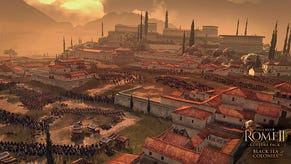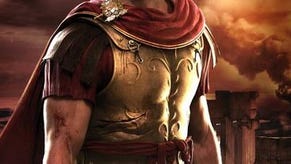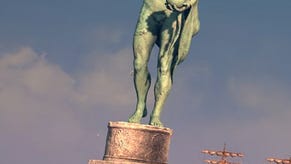Total War: Rome 2 – a vision in spandex
A visit to The Creative Assembly’s motion capture studio provides Stace Harman with the perfect excuse to don his spandex leisure-wear as he finds out what it takes to be a Roman legionnaire.
Inside an unremarkable-looking building nestled between a railway yard, a brewery and a greasy-spoon cafe, there unfolds a surreal scene that belies its modest surroundings. As a rudimentary combat-training session draws to a close, three faux Roman Legionnaires cast aside their rubber Gladii and makeshift shields to bust out a rendition of the YMCA. Inexplicably, one of the soldiers breaks ranks to run around flapping his arms like an agitated chicken.
Garbed in spandex that’s covered with highly reflective balls, I watch our actions played back on a Jumbotron screen. It’s at this point that I understand why my Nan is fuzzy on exactly what it is that I do for a living. However, all of this horseplay does have a purpose, as it’s taking place at The Creative Assembly’s motion capture studio. We’re here to discuss and, somewhat unexpectedly, experience firsthand what goes into depicting scenes of 2,000-year-old total warfare in 21st century West Sussex.
Total War: Rome 2 launches later this year for PC and is the first title to benefit from The Creative Assembly’s swish, new 46-camera motion capture set-up. It’s here, inside a 12mx13m capture volume, that the performances are recorded that underpin the thousands of animations required by CA, as the studio seeks to deliver its latest and most ambitious Total War title.
“One of the big things that we’re trying to do for Rome 2 is to make the men in combat feel and look much more convincingly human, so that it’s more visceral and brutal,” explains James Russell, lead designer of the Total War series. “We want it to look like these are men are really fighting their guts out for you.”
The practical implications of striving for such authenticity is many men spending many hours clad in spandex and going at each other with 20-inch rubberised implements. There’s never any danger of actual guts being spilled, of course, but nonetheless things can get rather heated, as CA motion capture manager Pete Clapperton explains.
“[The fight performers] really go for it. It’s choreographed to some respect, but we’ll just tell them kind of what we want and they’ll go out there and hammer it out with each other. There have been bruises and cuts but it’s quite an amazing thing to see.”
The data generated during these capture-sessions is analysed by Clapperton and his team in order to identify frames that require cleaning-up. This is most commonly necessary when fight performers have been locked closely together during combat shots, resulting in the data markers (or shiny balls, if you prefer) being obscured, which can lead to anomalies or missing data. Once the data has been processed, it’s sent just a spear’s-throw down the road to Creative Assembly’s HQ. Here, animators use it as a foundation to bring life (and death) to myriad soldiers, warriors and barbarians; hundreds of whom clash during scenes such as that shown in the “unmaking of Carthage” developer diary.
Significant investment in the new motion capture studio has seen a jump from around a dozen cameras to the 46 camera set-up that CA has access to now. The key advantages to Creative Assembly of having its own motion capture studio – and one that’s in such close proximity to its studio proper – are the quick translation of shoots into rudimentary game play footage, the faster iteration of animations and the volume of data that can be captured, manipulated and implemented in-game.
“Basically, it means that the money spent on the facility translates directly to what you see on the screen and allows for more variety of the animation,” says Russell.
Clapperton elaborates: “For one specific type of move, even if it’s a walk cycle, we’ll do 20 different walk cycles, cut those up into sections, introduce some loops and so out of those 20 [unique] cycles you could get 30 or 40 different walk cycles just from one actor on an hour’s worth of shooting.
"Even if it’s a walk cycle, we’ll do 20 different walk cycles, cut those up into sections, introduce some loops and so out of those 20 unique cycles you could get 30 or 40 different walk cycles just from one actor on an hour’s worth of shooting."
“The animations are weighted, so you don’t see the same thing each time. There are certain animations, like the death ones in Shogun that had some quite long sequences. You wouldn’t want to see that all the time, so we have the ability to manipulate it by selecting from a target animation name that has a handful of animations attached to it.”
The individuality shaped by the sheer number of animations being created for Total War: Rome 2 is further bolstered by a greater focus on the behaviour of different types of armies. While the Roman legions are disciplined to maintain formation wherever possible, some of Rome 2’s less well-ordered combatants favour a more chaotic, unpredictable approach. The barbarian tribes, for example, are more likely to charge the line as a mass of enraged, ferocious individuals than they are to concern themselves with the tactical niceties of standing should to shoulder with their brethren.
In coastal battles, ground troops must also contend with the carnage caused by war ships bombarding them from the sea. These individual elements are intended not only to add variety to the Rome 2’s aesthetics, but to also directly affect strategic game play choices and enhance its replay value.
Moving forward, it’s clear that it’s not just Total War: Rome 2 that will benefit from The Creative Assembly’s motion capture suite. The studio’s game based on Ridley Scott’s Alien will surely benefit from having 46 cameras trained on a marine who’s struggling to resist the terrifying embrace of a facehugger. Unfortunately, despite almost two years passing since the project was announced, both Russell and Clapperton are coy when it comes to discussing it in any detail.
However, while Russell’s position as lead designer on the Total War series perhaps precludes him from talking directly about the figurative elephant in the room, he is happy to talk literal elephants.
“The goal for us going forward will be to motion capture everything,” Russell says. “Because even in that great facility you can’t motion capture charging war elephants, so maybe that will be the next thing: to get an elephant in the room.”
Until such a time as The Creative Assembly negotiates the logistical hurdles of herding elephants through West Sussex, we’ll have to make do with thousands of soldiers waging bloody warfare on one another. It’s just a shame that none of the rousing pre-battle speeches or post-skirmish celebrations of Total War: Rome 2 will depict an uncoordinated trio performing the YMCA.
Total War: Rome 2 is expected on PC later this year.












